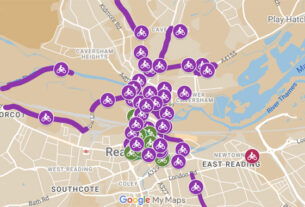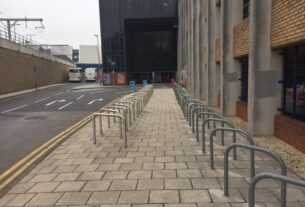
In 2017 the UK Government published its first Cycling and Walking Investment Strategy which sets out the Government’s ambition to make walking and cycling the natural choices for shorter journeys or as part of a longer journey. The Strategy sets a target of doubling cycle journeys by 2025.
As part of the Strategy the Department for Transport (DfT) is encouraging local authorities to develop Local Cycling and Walking Infrastructure Plans (LCWIPs). Reading Borough Council (RBC) has successfully bid for technical assistance in preparing a joint LCWIP with Wokingham and West Berks Councils; this technical assistance will be provided by an external consultant.
Reading Cycling Campaign has plenty of experience of cycling infrastructure designs drawn up by consultants and we hope that whoever provides the technical assistance ‘gets’ cycling, avoiding the temptation to interpret a Cycling and Walking Infrastructure Plan as a grandiose exercise in putting cyclists on footpaths in order to create a ‘cycle route’.
The DfT Guidance for Local Authorities on creating LCWIPs states: “effective engagement with stakeholders is critical to ensuring that high quality LCWIPs are produced.” RBC already has a Cycle Forum for cycle stakeholder groups, so is well placed to ensure that Reading cyclists have a meaningful input to the development of the LCWIP.
RBC has stated that “the core deliverables of the LCWIP will consist of the development of a network plan identifying preferred routes linking communities with local destinations and a prioritised programme of improvements for future investment.”
At this point it should be made clear that the LCWIP will be just a plan, it won’t have any funding attached to carry out the improvements. However, the DfT has made it clear that Local Authorities who have a plan will be “better placed to make the case for future investment” – and RBC does have a track record of successfully bidding for central government funding.
Sourcing the funding for cycle infrastructure improvements is key, but just as important is ensuring that money is spent effectively on infrastructure that really encourages cycling. In Reading we already have a mapped and signposted network of cycle routes, though these are of variable quality with regard to providing safe, direct and convenient routes for cyclists.
The next (and somewhat overdue) step is to progressively make changes to the road infrastructure to achieve a cycle network that will encourage a modal shift, similar to what we have seen happen in London, with all the benefits to congestion and air quality that would bring.
And the opportunities are there if the Council is willing to embrace them. In 2018 Cow Lane will be opened to two- way traffic, opening up the possibility of taking a large amount of traffic off Oxford Road.
Imagine what Oxford Road could be if there was a determined effort to make it pleasant to walk and cycle along? Perhaps that could be a catalyst to making West Reading a vibrant and pleasant area to live, work and shop.
Keith Elliott
RCC Secretary



